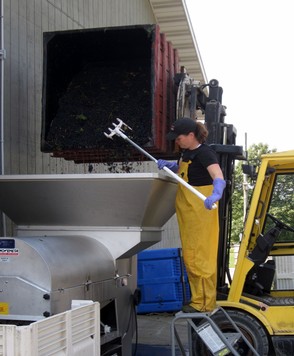Harvest Action
It is easy to imagine harvest in a Finger Lakes vineyard: picturesque rows of bright green foliage dripping with fruit so ripe it’s ready to burst, clear late summer sky, crisp sweet smelling air and bins full of tasty, sticky purple or green grapes ready to be carted to the winery! But then what? Once the grapes have been transported to the winery the vintner has literally tons of work to do! Recently I chatted with wine maker Lindsay Stevens about what harvest is like out side of the vineyard.
“Wine making is a cyclical process so we work all year long to empty the tanks in order to be ready for harvest. During harvest we spend one month filling all of the tanks,” Lindsay explains. In other words, for a winemaker, this is show time. From the moment the grapes arrive her decisions influence how the wine will turn out.
The first portion of the Chardonnay grapes have already been harvested, crushed and de-stemmed, pressed and relocated to barrels to complete fermentation and age. They were the first grapes picked this year and due to such a hot dry summer they were ripe over a week earlier than ever before: the second of September! About five of our twenty eight acres are chardonnay and not all sections are ripe at the same time. So the last batches arrived at the winery on the 15th and by that time the fist batch of juice has already completed fermentation!

Assistant Winemaker Colleen Lucas preping barrels
Let’s back up a little. Before the grapes have even been picked there is a lot of physical work to be done by Lindsay and her assistant, Colleen Lucas. Before juice is transferred to barrels, each one has to be tested to make sure it will hold liquid. This is done by power washing each barrel with hot steam to ensure that the staves can still expand with absorbed water. When the barrels are empty for a period of time the wood dries and shrinks leaving gaps where juice can escape. A small amount of hot water is also added (much more conversationalist than filling the entire barrel). The bung, the rubbery plug that stoppers the barrel, is inserted. After the water cools and the bung is removed if there is a dunk then Lindsay knows that a negative vacuum was created and that the barrels are good to hold the precious juice!
Winemaker Lindsay Stevens raking grapes into the crusher/de-stemmer
The same day that the grapes are picked they are put through a machine that we call the crusher/de-stemmer and it does exactly that! The stems and seeds must be removed because they have an unpleasant flavor that would make the juice taste bitter. The next step differs for red and white grapes. The crushed red grapes are moved straight to tanks where the juice begins fermentation while still in contact with skins. This gives red wine color and tannin. In white wine tannin is called phenolics and is not desirable so, they are “pressed” in a huge machine that squeezes the fruit to separate the juice from pulp. The clear juice is then pumped into a stainless steel tank to settle before fermentation.
I had the opportunity to taste the freshly pressed juice of the chardonnay grape. It was the texture of orange juice and a murky off white color but it was sweet, fruity and delicious!
Our traditional Chardonnay is our only variety that is both fermented and aged in oak. Fermentation is initiated in the tanks but completed in barrels. A secondary fermentation also occurs called malolactic fermentation in which bacteria convert malic (or fruity) acid to lactic acid giving the wine its smooth creamy texture. The bacteria won’t be active until the fermentation slows down but they need to be added before so that the sudden exposure to alcohol is not a shock. Lindsay said the bacteria is “hanging out in the hot tub” until it’s time to work. It is her job to oversee the whole process so I often see her in the barrel room with beakers, eye dropper and other gadgets.

Freshly picked pinot noir grapes
The vines know when fall is coming because of that so the vines protect themselves by ripening fruit so that the seeds can spread. The next grapes harvested were the Pinot Noir, a smaller section of the vineyard. For reds you get more tannin accumulation when its warm during the day and cool at night so the weather the last few weeks has been ideal. The pinot noir now sits in containers in the barrel room where Colleen presses the skins down into the juice to maximize color, tannin and flavor before fermentation is complete and the skins are removed.
If you visit the winery during harvest, take a look in the barrel room. When you walk in you will be hit with the sweet aroma of fermenting juice. The chardonnay smelled just like banana bread and now the pinot makes the air rich and fruity. It is truly an exciting time for everyone in the wine industry. You can see some of the action on October 6th and 7th at our harvest festival!
